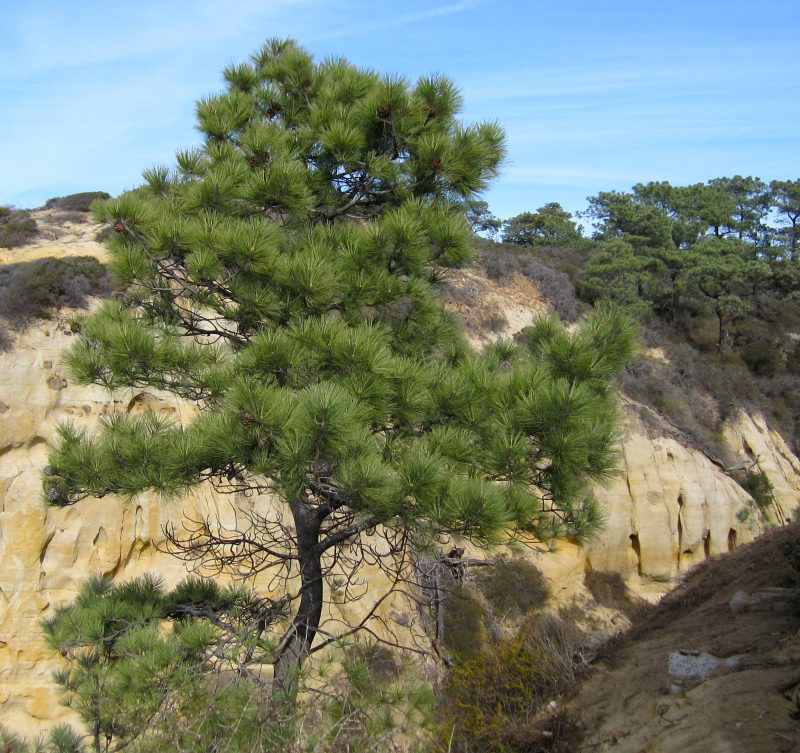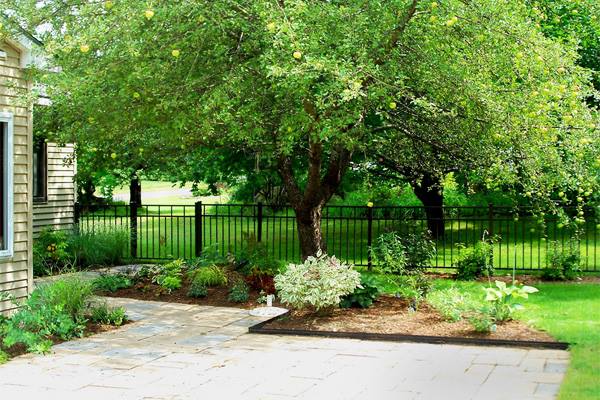
San Diego is losing its Torrey Pines at an alarming rate, due to drought and lack of care.
Have you noticed changes in the landscaping along San Diego’s freeways? Caltrans has cut a lot of trees down, replacing them with low profile, low water use landscaping. I bet Caltrans is doing this in other areas of California as well.
Caltrans isn’t alone. KPBS Radio reported 100 trees have been removed from the Torrey Pines Preserve, which is a lot more than the yearly average. Twelve MILLION trees died in California state forests in 2014 because of the drought. Almost 90,000 of those were in San Diego County.
All over the state, our urban and suburban street trees are being removed due to drought, disease, and because they’ve become street hazards raising sidewalks. There are now 16 million empty spots waiting for replacement street streets in the state.
When trees suffer because of the drought, they become easy prey for diseases and insects like bark beetles. In most ecosystems, it wouldn’t be such a horrible thing to have dead and dying trees. It’s all part of the natural cycle. Bare tree branches provide habitat, and the roots prevent soil erosion. But they are also fuel for wildfires. This tinder is too great a fire hazard in our wildfire prone state.
So, out they come. But what happens when we don’t replace them? Green roofs, living walls and vertical gardens can only do so much to green our urban spaces. We need mature trees planted in the ground.
Trees need water. But trees also contribute to the water cycle in ways many people don’t realize. Trees are nature’s water conservation heroes. Studies show that trees clean the air by filtering pollutants and producing oxygen. Other studies show that trees reduce crime! Trees reduce soil erosion. Trees reduce energy costs by providing shade and cooling the air, which produces a natural way to offset the scorching heat coming from streets, concrete and buildings. We call this the “urban heat island effect.” California street trees alone save the amount of electricity it would take to air condition 530,000 households every year.
When it does rain, like our recent storm in San Diego, trees provide mitigation of runoff. They soak up rain water and store it in their biomass (leaves!) instead of letting it wash down storm drains, taking oil, anti-freeze, pesticides, cigarette butts, and plenty of other chemicals and trash which eventually end up in the Pacific Ocean. Yuck.
Trees add value to your home and your entire neighborhood, sometimes tens of thousands of dollars. Who doesn’t love a tree lined street?
A recent report by the U.S Department of Agriculture Forest Service shows that the number of street trees in California is running behind population growth. Street trees make up 10 percent to 20 percent of the state’s total urban forest. Tree density has declined 30 percent since 1988 as cities have added more streets than trees. Tree density fell from 105.5 trees per mile to 75 trees per mile in this period.
If we take out trees and don’t replace them, it reduces habitat for wild animals. Birds that are migrating through or other animals that rely on trees for shelter and food will not have those trees anymore.

Want to increase the value of your home and improve your neighborhood and the environment? Plant a tree. Photo Courtesy Invest In Trees
If you are wrestling with the decision whether or not to take out any trees on your property, my advice is this: removing trees to save water in the drought should be your last resort. It can take decades to replace a mature tree. In the meantime, we have all lost out on the benefits. Your trees should be your number one priority for outdoor watering.
All the attention has gone to lawns. Yes, lawns are thirsty. But a dead brown lawn will bounce back the minute it gets some water. Dead trees can’t bounce back. It takes 10, 20, even 50 years or more for a tree to grow back and provide the benefits you lose.
Older, mature trees can stand up to drought better than young, immature trees. All trees need about 10 gallons of water per inch of trunk diameter every time you water. If you have a tree trunk eight inches in diameter, it will need 80 gallons of water. Most trees should be watered every 10 days, three times monthly, from April to September. You can back off to once or twice monthly from October through March.
If you are vigilant with your water conservation efforts, you can make up a lot of the difference. This is a perfect use for the water saved from your shower heating up. If you can reduce your toilet flushes by one or two daily, this makes up 40 to 80 gallons monthly. Consider ways you can use water from your shower and rinse water from your washer in a greywater system. Redirect rain gutters toward your trees – it sure would have made a difference last weekend, and if we get any El Nino effect this winter it will help a lot.
If you do have to replace a dead tree, try to replace it with a native type of tree or one that flourishes in a similar dry climate that used to less water. Ask your favorite nursery, arborist, or landscaping professional for suggestions. But it makes no sense at all to cut down a mature healthy tree, even if it’s not a native.
There is a lot more great information out there, The California Urban Forests Council has a chart that will help you. The Council also has a Facebook page called “Invest in Trees.” Follow it and help educate your family and friends about the value of trees by sharing it.
The drought is scary, but we need to think long term about the future and not take short-term measures to solve a long-term problem.
